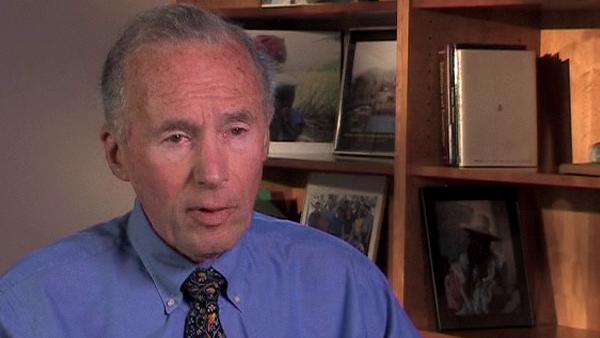NEXT STORY

Battling on behalf of Beth Israel Medical Center
RELATED STORIES

NEXT STORY

Battling on behalf of Beth Israel Medical Center
RELATED STORIES


|
Views | Duration | |
|---|---|---|---|
| 11. How I cost Stanford University $150 | 101 | 01:57 | |
| 12. An American in Paris | 97 | 04:27 | |
| 13. A year at the Pasteur Institute in Paris | 1 | 66 | 06:41 |
| 14. Return to Boston | 66 | 01:48 | |
| 15. Getting the Chair of Medicine at Beth Israel Medical Center | 67 | 02:55 | |
| 16. Building the Department of Medicine at Beth Israel | 61 | 03:32 | |
| 17. Battling on behalf of Beth Israel Medical Center | 86 | 05:28 | |
| 18. Selecting Bill Silen as Professor of Surgery | 66 | 02:40 | |
| 19. 'What do you think of the National Health Service?' | 66 | 03:24 | |
| 20. Developing health programs in the community | 52 | 00:56 |


At that point the department, the hospital was relatively small as compared with the other Harvard teaching hospitals. The department had very little in the way of research activity. There was Hermann Blumgart's work in cardiology and the work of a few others of his colleagues, but the opportunity to, to build that department was a great one and simultaneously... simultaneously the other departments in the hospital were being vacated, incumbents were retiring, so it presented an opportunity to have a voice in the leadership of the entire institution, and it was at that point that I approached a couple of the people whom I knew slightly who had departments that I admired greatly. One was Robert Loeb at... at Columbia Presbyterian, the other was Walter Bauer at the Mass General in Boston, both offered me encouragement. I asked both for suggestions of people I might recruit. Bob Loeb said, 'If I were you, I would look to Irv Goldberg. He's a man that has been with me for several years on my house staff, went from there to Rockefeller University to take a PhD with Fritz Lipman, and then went to the University of Chicago where he has been just a year or two'. So, I recruit Irv, and together we... we built the Department of Medicine at, at Beth Israel. One of the people who had been there, Dick Nesson, was somebody I came to know well during my days there, and I engaged him as my... as the person who would help develop the... the medical service and clinical teaching programs and he was extremely capable in that realm.
So, we recruited a group of people who had science backgrounds and strong clinical backgrounds, and it was a climate that was just marvellous. All of these people considered themselves physicians first, their caring for patients was of the highest degree. They considered themselves teachers. The service soon became the most sought after by Harvard medical students for residency training and it became a place where very interesting research was carried on. So, it, it was really an extremely attractive setting in all of these ways. The patients first, teaching and research second.
Born in 1925, American Howard Hiatt set up one of the first medical oncology research and training units in the US and has headed up some of America's most prestigious medical institutions. Hiatt attended Harvard College and received his MD from the Harvard Medical School in 1948. He was a member of the team at the Pasteur Institute, Paris, that first identified and described mRNA, and he was among the first to demonstrate mRNA in mammalian cells. From 1991 to 1997, he was Secretary of the American Academy of Arts and Sciences, where he began and directs the Academy's Initiatives For Children program. He is also committed to helping disadvantaged people access decent health care.
Title: Building the Department of Medicine at Beth Israel
Listeners: Milton C. Weinstein
Milton C. Weinstein, Ph.D., is the Henry J. Kaiser Professor of Health Policy and Management at the Harvard School of Public Health and Professor of Medicine at the Harvard Medical School. At the Harvard School of Public Health he is Academic Director of the Program in Health Decision Science, and Director of the Program on Economic Evaluation of Medical Technology . He is best known for his research on cost-effectiveness of medical practices and for developing methods of economic evaluation and decision analysis in health care. He is a co-developer of the CEPAC (Cost-Effectiveness of Preventing AIDS Complications) computer simulation model, and has conducted studies on prevention and treatment of HIV infections. He is the co-developer of the Coronary Heart Disease Policy Model, which has been used to evaluate the cost-effectiveness of cardiovascular prevention and treatment. He is an author of four books: Decision Making in Health and Medicine: Integrating Evidence and Values; Cost-Effectiveness in Health and Medicine,the report of the Panel of Cost Effectiveness in Health and Medicine; Clinical Decision Analysis; and Hypertension: A Policy Perspective.He has also published more than 200 papers in peer-reviewed medical, public health, and economics journals. He is an elected member of the Institute of Medicine of the National Academy of Sciences, and a recipient of the Award for Career Achievement from the Society for Medical Decision Making. Dr. Weinstein received his A.B. and A.M. in Applied Mathematics (1970), his M.P.P. (1972), and his Ph.D. in Public Policy (1973) from Harvard University.
Tags: Beth Israel Medical Center, Robert Loeb, Irving Goldberg, Dick Nesson
Duration: 3 minutes, 32 seconds
Date story recorded: September 2006
Date story went live: 24 January 2008